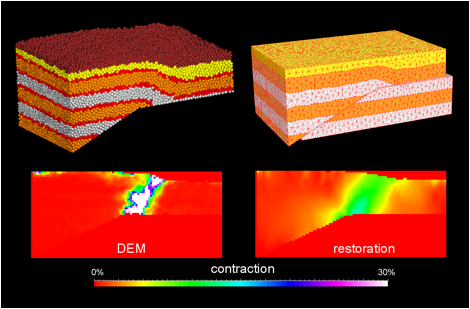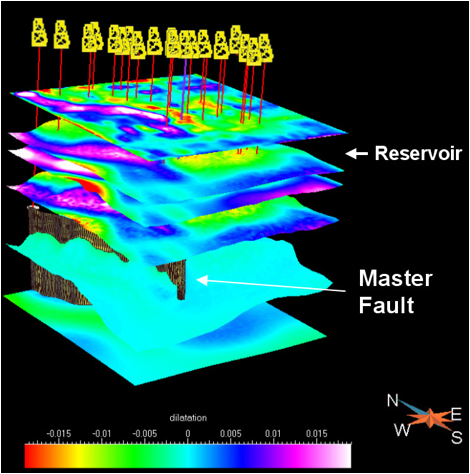www.acsprf.org
Reports: AC848385-AC8: New Approaches to 3D Structural Restorations Using Mechanical Constraints for Improved Petroleum Trap and Reservoir Characterizations
John H. Shaw , Harvard University
The goal of geologic
restorations is to remove slip on faults and unfold sedimentary strata in a
manner that obeys balancing constraints. Traditionally, these restorations have
been performed using geometric approaches that are inherently two-dimensional,
and do not consider rock strengths. In contrast, the geomechanical
restoration techniques that we employ are capable of performing fully
three-dimensional restorations that are governed by rock properties. The
methods employ elastic constitutive laws that are simple approximations of the
naturally complex deformation processes in geologic structures. Thus, we benchmarked these new methods by
restoring a series of mechanical forward models developed with the discrete
element method (DEM). These DEM models generate complex structures similar to
natural systems, yet we know the full displacement, strain, and stress fields
for these mechanical models. Applying the restoration methods to these forward
models gave us an ability to assess quantitatively how well the restoration
technique performs in describing complex deformations under specific sets of
boundary conditions. Our results indicate that the geomechanical
restoration approaches are capable of recovering three-dimensional displacement
fields for faulted and folded structures (Figure 1). In particular, these
restorations perform best in cases where fault geometries and displacements
governed displacement fields. Restoration strains were also shown to closely
approximate strain patterns in the forward models. The restoration generally
defined the regions of high strains and their average magnitudes for a wide
range of structural models. This gives us confidence that the geomechanical restoration approaches, despite their
inherent limitations, can be applied successfully to restore structures in
three dimensions and to map the distribution strains within them.
The second phase of our efforts focused
on applying these restoration techniques to natural petroleum traps, and on
comparing strain patterns derived from the restoration with geophysical
attributes and geologic observations that help to constrain reservoir
properties such as fracture density. In these efforts, we have collaborated
with a number of industry sponsors, and our project areas include fields in
California, China, the Caspian Sea, and the Arabian Peninsula.


